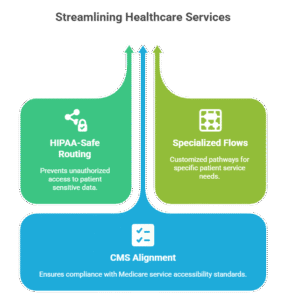On-Demand Outsourcing BPO Services for Healthcare Providers With 24/7 Coverage!
Save up to 70% on staffing costs!
Browse Specialty Staffing ServicesCalibrated IVR Options in Healthcare to Minimize Transfers Without Confusing Patients

In US healthcare, your call center isn’t just answering phones — it’s handling the first step in patient engagement and protecting operational efficiency.
The problem? Every unnecessary transfer costs staff time, frustrates patients, and risks losing revenue from missed or delayed appointments. According to MGMA benchmarks, each misrouted call costs an average of $4–$6 in staff time — and that adds up fast in busy hospital systems.
Calibrated IVR (Interactive Voice Response) solves this by carefully designing phone menu options that get callers where they need to go on the first try — without making them fight through endless prompts or confusing jargon.
Why Calibrated IVR Beats “Set It and Forget It”
Most IVR menus fail for one of two reasons:
-
They’re too simple, forcing patients to speak to live staff for every request.
-
They’re too complex, creating frustration and hang-ups.
Calibrated IVR finds the sweet spot — routing calls efficiently while maintaining a patient-friendly experience.
Operational & Financial Impact for US Providers
-
Reduce Call Transfers by 30–40% – Fewer internal handoffs free up your call center to handle more calls without adding staff.
-
Lower Abandonment Rates – Clear options keep patients on the line, improving scheduling rates.
-
Cut Operational Costs – Everest Group research shows that every 10% reduction in call transfers can save mid-sized US health systems $50,000–$80,000 annually.
-
Boost Patient Retention – Less friction means fewer patients drop off before booking or resolving an issue.
Compliance & Accuracy Benefits
In healthcare, misrouted calls aren’t just a nuisance — they can be a compliance risk.

-
HIPAA-Safe Routing – Ensures patient information isn’t accidentally shared with the wrong department.
-
Specialized Flows for Sensitive Services – Tailored paths for behavioral health, billing disputes, or Medicare/Medicaid cases.
-
CMS Alignment – Supports Medicare patient service requirements for accessibility and timely responses.
How to Build a Calibrated IVR That Works
-
Analyze Call Data – Identify top call reasons, misroutes, and average handling times.
-
Prioritize High-Volume Paths – Put your most common requests at the top level.
-
Use Plain Language – Replace “Eligibility Verification” with “Check My Insurance.”
-
Test with Real Callers – Pilot with patients to ensure no step feels like a dead end.
-
Integrate with EHR & RCM – So scheduling, billing, and eligibility checks can happen instantly.
The Revenue Cycle Link
A well-designed IVR isn’t just a convenience — it’s a front-end RCM safeguard.
-
By routing insurance questions directly to eligibility teams, you reduce downstream claim denials.
-
Connecting payment options directly in the IVR can speed up patient collections without staff intervention.
Measurable Results from Calibrated IVR
For a mid-sized US hospital network:
-
38% reduction in internal call transfers.
-
$96,000 annual savings in call center labor.
-
12% improvement in appointment conversion rate.
-
Faster response times for priority calls (triage, urgent scheduling).
What Did We Learn?
Calibrated IVR is not about making patients “press 3 for more options.” It’s about creating a data-informed, compliance-safe, patient-friendly routing system that saves money, improves satisfaction, and directly supports your revenue cycle goals.
Staffingly, Inc. can design and implement a calibrated IVR solution for US healthcare organizations that delivers operational efficiency, measurable cost savings, and HIPAA-compliant call routing.
What people are asking?
Q: How can IVR reduce hospital call center costs?
By routing calls accurately the first time, IVR reduces the need for transfers, saving staff hours and lowering operational costs.
Q: What’s the ROI of calibrated IVR for US healthcare?
Savings range from $50K–$100K annually for mid-sized systems, with additional gains from improved scheduling and payment capture.
Q: Can IVR handle HIPAA compliance?
Yes — when designed to route calls without exposing patient data to the wrong department or unauthorized staff.
Q: How does this impact patient satisfaction?
Fewer transfers mean less wait time, which improves appointment retention and overall patient experience.
Disclaimer:
For informational purposes only; not applicable to specific situations.
For tailored support and professional services
Please contact Staffingly, Inc. at (800) 489-5877
Email: support@staffingly.com
About This Blog: This Blog is brought to you by Staffingly, Inc., a trusted name in healthcare outsourcing. The team of skilled healthcare specialists and content creators is dedicated to improving the quality and efficiency of healthcare services. The team passionate about sharing knowledge through insightful articles, blogs, and other educational resources.
 Book a Demo to Build Your Team Today!
Book a Demo to Build Your Team Today!

 Read Case Studies
Read Case Studies 



 Virtual Medical Assistants
Virtual Medical Assistants



